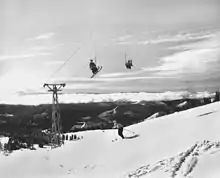
The Riblet Tramway Company of Spokane, Washington,[1] which operated from 1908 to 2003, was once the largest ski chairlift manufacturer in the world.
The company was founded by Byron Christian Riblet, who was born in Osage, Iowa, in 1865 and earned a degree in Civil Engineering. Arriving in Spokane in 1885, his first work was laying out railway and streetcar lines. He also built dams and irrigation projects.
In 1896, Riblet was contracted to erect an ore tramway designed by the Finlayson company at the Noble Five silver mine in Sandon, British Columbia, to assist in moving ore down Reco Mountain to the mill at Cody. Apparently Riblet thought he was coming to build a streetcar line. Even so, Riblet decided he could improve the mining tram performance. Over time, Riblet raised more aerial tramways in the booming mining district, building 30 in the next decade. Riblet returned to Spokane in 1908, after working in the Kootenays, to found the Riblet Tramway Company. The company, which specialized in mining tramways, built them in Alaska, Canada, the western United States, and South America.
Riblet built its first chairlift in 1938 at Mount Hood, Oregon. Byron Riblet died in 1952, but the company boomed with the postwar rise of ski resorts. Skiing gained in popularity, and soon ski lifts became the major part of the Riblet Tramway Company's business. They built more than 400 lifts, particularly in Washington, Oregon, and California, and as far away as Australia, New Zealand and Chile; one secondhand American lift has also been relocated to Pakistan.[2] They have the most double chair lifts operating in the U.S.
The company only built fixed-grip lifts, whose chair grip is woven into the haul rope rather than clamped onto it. But other technologies eventually proved more popular. In early 2003, the firm announced that it was no longer viable and would go out of business.[3]
Installations
Riblet chairlifts can be found in many places still in service, though the majority have been removed. The following tables contain those documented by liftblog.com as of September 5th, 2021. More Riblet chairlifts may be in existence, though some listed below may have already been removed. At least 265 existing Riblet chairlifts still exist and 268 are no longer installed.
| Location | Ski area name | Remaining | Removed | Reference | Additional notes |
|---|---|---|---|---|---|
| Alberta | Castle Mountain | 1 | 0 | https://liftblog.com/castle-mountain-ab/ | |
| British Columbia | Apex | 0 | 1 | https://liftblog.com/apex-bc/ | |
| British Columbia | Cypress Mountain | 0 | 1 | https://liftblog.com/cypress-mountain-bc/ | |
| British Columbia | Kicking Horse | 1 | 0 | https://liftblog.com/kicking-horse-bc/ | |
| British Columbia | Whitewater | 0 | 2 | https://liftblog.com/whitewater-bc/ |
See also
- Detachable chairlift: the technological successor to the fixed-grip chairlift
- Magic Mile, Riblet's first chairlift
References
- ↑ Riblet website, retrieved 2012-10-18
- ↑ Osberger, Madeleine. "Where chairlifts go in their next lives". Aspen Daily News. Retrieved 30 December 2021.
- ↑ Sowder, Douglas (2003-05-13). "To: Our Friends in the Ski Industry". Riblet Tramway Company. Retrieved 2007-01-23.
Sources
Martin J. Wells (December 2005). Tramway Titan: Byron Riblet, Wire Rope and Western Resource Towns. Trafford Publishing, Victoria. ISBN 978-1-4120-5093-7.